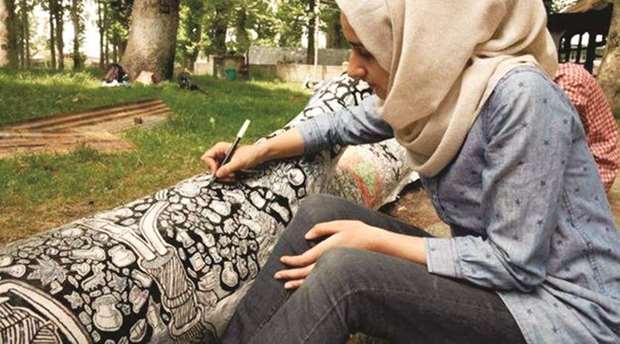Often cinema is a casualty of an administration that is uncomfortable with truth. In today’s India, motion pictures appear to have caught the eye and attention of the Central Board of Film Certification and the Information and Broadcasting Ministry – often unnecessarily so. Movie after movie has been put under the scanner, and asked to chop scenes and dialogues that are termed objectionable or seemingly have the potential to cause communal disharmony. But often this a mere excuse to cover uncomfortable facts.
Take for instance, Lipstick Under My Burka (or Lipstick Waale Sapne) – which I saw last year at the Tokyo International Film Festival and which I thought was a riveting story of four women struggling to be independent, struggling to achieve sexual freedom, struggling to have a greater say over their bodies. The movie was not given screening rights for a long time, till the film director, Alankrita Shrivastava, fought a bitter battle with the Board and won, though on the assurance that she would accept an adults-only certificate and voluntarily cut a few scenes. I sometimes suspect that the Board gets on to an ego trip, not wanting to be seen as giving in!
In recent months, such incidents of censorial highhandedness have been rising, and the latest now relates to the just ended 10th edition of the International Documentary and Short Film Festival in Thiruvananthapuram. The Festival is the only one among the couple of such events in India that encourages documentary cinema in an unhappy scenario where there is hardly any theatrical outlet for it.
The Ministry refused censor exemption to three documentaries that were to be shown at the Festival. These movies deal with subjects such as the tragic suicide of a Dalit scholar, Rohit Vemula, the current unrest in Kashmir and last year’s demonstrations in Delhi’s Jawaharlal Nehru University (JNU).
While PN Ramachandra’s The Unbearable Being of Lightness centres on the student protests in the University of Hyderabad after the suicide of a frustrated Vemula, Kathu Lukose’s March March March takes us to the days when JNU students rose in revolt last year. In the Shade of Fallen Chinar by NC Fazil and Shawn Sebastian zeroes in on the Kashmir Valley and talks about how college students have been using art forms as a means of resistance and defiance in these extremely volatile times.
Lukose was a student at the JNU at a time when the campus was on a boil. The period stretched from February to September 2016, and as a Master’s fresher of Art and Aesthetics, Lukose recorded what she felt was a defining moment in the history of student movement. An 18-minute documentary, March March March, was what emerged from her camera, a film which begins with the February 9 demonstration against the executions of Afzal Guru, convicted of attacking India’s Parliament in 2001, and Kashmiri Separatist Maqbool Bhat.
Little did Lukose realise then that her shutterbug of a March would lead to a huge controversy that we saw on the eve of the landmark 10th edition of the Festival. The documentary was not granted permission by the Ministry. This is a must for any Indian picture without the usual certificate from the Board.
Speaking to me the other day from a train travelling to Kochi to file a petition in the Kerala High Court pleading for a stay against the Ministry’s decision, Lukose averred that there was nothing “remotely controversial in her work. If only someone had seen it, instead of just going by the synopsis, March March March would have marched on and ahead”. Unfortunately, the Court dismissed her plea and also that of Fazil/Sebastian.
Fazil, who made In The Shade Of Fallen Chinar, was also a student like Lukose. Studying for a Master’s degree in Communications at Hyderabad, Fazil was on an internship in Kashmir in June 2016, when he was fascinated by the way students were using art forms to protest against what was happening in the Valley. They chose a space just around a fallen chinar tree to paint graffiti proclaiming their displeasure against the violence being unleashed on the people of Kashmir. The youngsters also brought out a tabloid called Mizraab.
The third film on the block was P N Ramachandra’s The Unbearable Being of Lightness – which reflects on the suicide of Vemula in January 2016. Ramachandra was all set to conduct a communications workshop in Hyderabad University when the unfortunate incident took place. And he thought that it was important to record what followed the death.
Incidentally, this was the not the first time that the Festival experienced such a storm. Last year, two documentaries were not given permission. Jayan Cherian moved the Kerala High Court, which then directed the Ministry to let his Ka Bodyscapes be exhibited at the Festival. But the celebrated Iranian helmer, Majid Majidi, was not as lucky. His Muhammed could not be shown.
It is in this context I remember the 2014 Busan International Film Festival where a documentary, The Truth Shall Not Sink With Sewol – describing how the state machinery failed when a ferry boat sank killing 304 men, women and children – was considered “not suitable”. Seo Byeong-soo, Busan Mayor, asked the Festival not to screen the movie.
But the Festival chief, Lee Yong-kwan, went ahead and showed the documentary, which presented a devastating picture of how lives could have been saved if only the authorities had been efficient enough.
Later, when Lee was punished, the international film festival fraternity and the movie industry in South Korea stood by him.
Perhaps, we in India need similar unity and movement. Or, would that be asking too much?
*Gautaman Bhaskaran has been writing on international film festivals and movies outside them for close to four decades, and may be e-mailed at [email protected]

Screen grabs from In the Shade of Fallen Chinar.


